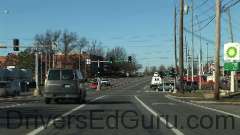Stage 3: Intersections – Part 1
Intersections are probably the most dangerous area on the road. While highways and expressways can be intimidating due to their high speeds, intersections provide a much tougher challenge for all drivers, especially those new to the road.
Generally, there are two types of intersections:
- T-intersections (3-way intersections): one road terminates at the intersection.
- 4-way intersections: two roads cross.


As a point of fact, there are 5-way and 6-way intersections. We have yet to find a 7-way intersection, but believe that it must exist somewhere.

Traffic control devices
Intersections are oftentimes classified by the type of traffic control device that controls the intersection. The most common are:
- Uncontrolled: These are typically found at T-intersections. The right-of-way rule states that the through-road has the right-of-way. So, if your road ends at the intersection, you must yield the right of way. However, if you encounter a 4-way uncontrolled intersection, yield right of way to the right.
- Stop-controlled: There are stop signs controlling traffic flow at the intersection. Two-way and four-way stops are the most common.
- Signal-controlled: These are intersections where a traffic light or signal controls the flow of traffic.
For completeness sake, there are other control devices used at intersections. Yield signs, traffic circles, and box junctions are also used. There’s also a thing called the “Michigan-Left” which is actually kind of a cool way to handle traffic congestion.
Identification
The reason we’ve recapped this basic driver’s ed information is because the first task for any driver approaching an intersection is to determine how it is controlled. You need to ask yourself, “Is this intersection controlled by a signal, a stop sign, or is it uncontrolled?” This information is crucial because it tells you how other drivers should behave as they approach the intersection. To practice this with your teen, use <commentary driving> as you approach an intersection. Simply ask them how the intersection is controlled. For example:
“What kind of intersection are we approaching?”
“A four-way.”
“How is it controlled?”
“By stop signs on our road, but not on the cross street.”
“So, will drivers on the cross street have to yield the right of way to us?”
“No.”
Closure Rates
The closure rate is the amount of time it takes a car to reach a certain point (usually your location). Teens are notoriously bad judges of closure rates. Part of this is due to inexperience with judging closure rates. Teens also have a tendency to glance too quickly at approaching cars. Unless you watch a car for a few seconds, it’s impossible to gauge how fast it’s traveling.

Practice determining closure rates
Head to a busy intersection and hunker down in a safe place near the road. Near our house, there is a bookstore on the corner of a busy intersection. Me and my daughter were able to sit down outside, enjoy a coffee, and practice judging closure rates. She probably wasn’t as thrilled about doing this as I was, but once we started, she realized how poor of a judge of closure rates she really was.
- Have your teen pick out an approaching car and guess how many seconds it’ll take them to reach your position.
- Your teen should count the seconds out loud saying, “one one thousand, two one thousand …”.
- Once they are able to successfully judge the closure rate of five different cars in a row, you can relieve them of the humiliation of being with you in public
 .
.
Remember: Closure rates can only be determined by watching a car for several seconds. While a quick, quarter-second glance may help you determine how far away a car is, it is not sufficient to determine how fast it is traveling.
Read Intersections Part 2 for more information and exercises.

